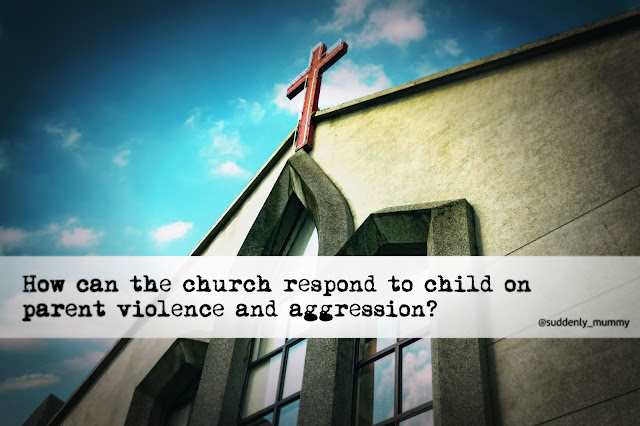After a long break, I have been galvanised into blogging today by an article published by the Christian organisation, Premier. The article (available to read here) is an uncritical report of the comments of a Christian author (who I...
After a long break, I have been galvanised into blogging today by an article published by the Christian organisation, Premier. The article (available to read here) is an uncritical report of the comments of a Christian author (who I have never heard of) on the recent news reporting of an increase in child on parent violence and abuse. Basically, the parents are to blame. Oh, and also schools, the media and society. But mostly the parents. A bit more smacking probably wouldn't hurt either.I would imagine that many would have had strong opinions on seeing news articles about child or adolescent violence and aggression towards parents. It is, thankfully, an experience that will be far removed from the reality of most families, but in the adoption and fostering community, and in the SEND parenting community, it's a subject that is raised time and time again. For many of us, seeing it spoken about in the news was not a surprise or a shock. For some, it was a relief to see a problem so drenched in secrecy and shame being openly discussed.
There is actually a lot of research on the topic already. The Christian author in question may have done better to acquaint herself with some of it, perhaps on Helen Bonnick's excellent website, Holes in the Wall. It is more common than many would think, and not restricted to any particular type of family or child. The causes are many and varied and, surprise surprise, not restricted to poor or lazy parenting.
Neither is it only about aggressive teenagers turning on their parents in fits of rage. In a recent Adoption UK survey, 65% of parents said they had experienced violent or aggressive behaviour from their children of all ages. Parents and carers of children as young as three or four years of age have reported violence and aggression. Perhaps the recent apparent rise in the problem is less an issue of an increase in this phenomenon, and more about an increase in parents and carers who are prepared to talk about what is happening in their home.
For parents of children who, for a range of reasons, have difficulty expressing their strong emotions through words, lack impulse control, lack the ability to regulate themselves, are fuelled by anxiety and trauma, and sometimes display violent and challenging behaviour, the response of the church needs to be better than what was published in that Premier article.
If you are a leader in your church, or even just a member, what then should your response be to hearing that some families, maybe even families within your church, are experiencing child on parent violence and aggression in their home?
Here are a few ideas:
Listen without judgement. It takes a great deal of courage to open up about a subject which even now is a source of great embarrassment and shame. Parents likely already fear that they are in some way to blame, and reinforcing this only closes down the conversation, sending parents back into their shame and denying them the help they so desperately need. Avoid looking for easy solutions. Many parents will already have tried all the usual things and found that it has not worked. If a child has, for instance, foetal alcohol spectrum disorder which means that they find self-regulation incredibly difficult, a sticker chart is not going to provide an instant cure. It should hardly need explaining that teaching a child not to hit by hitting them yourself is unlikely to be a useful strategy. Do some research. There is plenty of information available about child on parent violence and aggression, as well as support groups on social media. If you are supporting a family in this situation, find out something about it. The Holes in the Wall website mentioned above is one place to start. You could also look into specialised parenting strategies designed to help families break the pattern, such as NVR, and offer to become a supporter of the family. There is more information on NVR here - Sarah Fisher is a qualified NVR practitioner who helps hundreds of families. Offer practical support. Struggling families sometimes need a break. It may not be possible or appropriate to offer to babysit the child or young person, but perhaps you could cook a meal, take the family dog for a walk, do some shopping or laundry or lighten the load for them in some other way. Offer a welcome. Too many families raising children with 'challenging behaviours' find it hard to locate a welcoming church that accepts their family. Some children can be loud and boisterous, struggle with the noise and bustle of a busy church, present challenges to volunteer Sunday School teachers, have very public meltdowns, and this can make it extremely difficult for the family to join in with the life of the church. How can your church make adjustments to welcome and include struggling families? Home for Good has a series of articles on this subject here.
It is tempting, but futile, to look for easy answers to complex problems. We are all inclined to view the experiences of others through the tinted lenses of our own life experiences, but this approach will mean that, time and time again, the church will fail those whose backgrounds, experiences and challenges are in any way outside the 'norm' as we perceive it. We can and should do better. Dare I say, I believe it is our Christian responsibility to do better.
****************************************************************
Edit: the original Premier News article has now been updated to include some more measured comments from Al Coates, a Christian social worker, adoptive parent, and friend, who has researched and campaigned on child to parent violence and aggression. I am thankful that they listened and amended the article so quickly. Please do go and read what he has to say at the bottom of the article.















